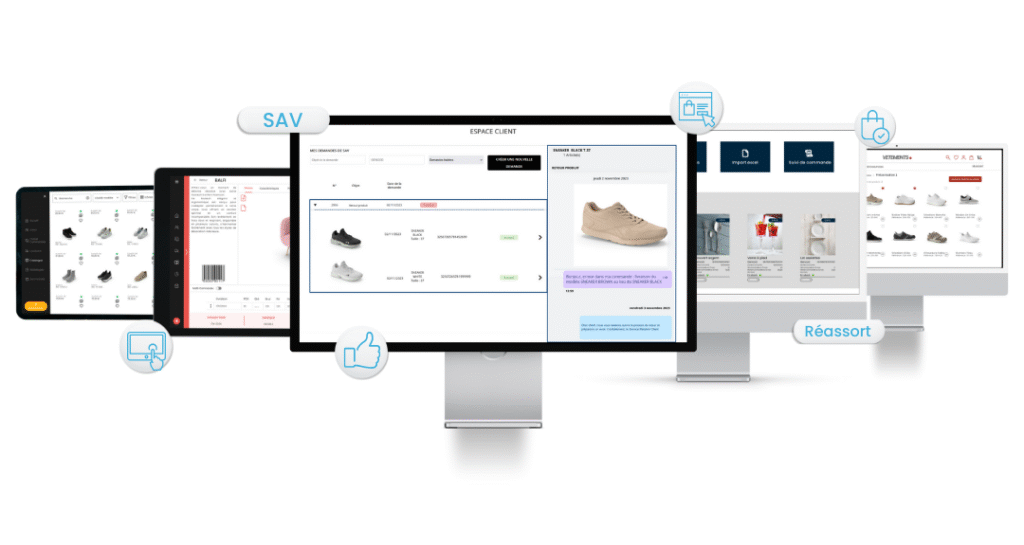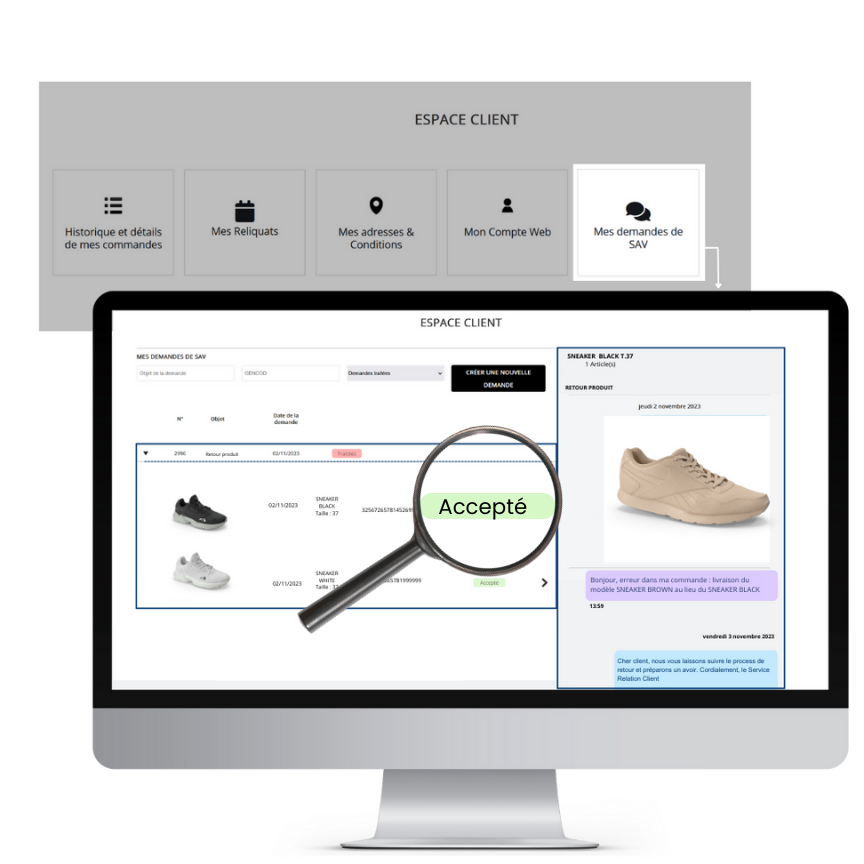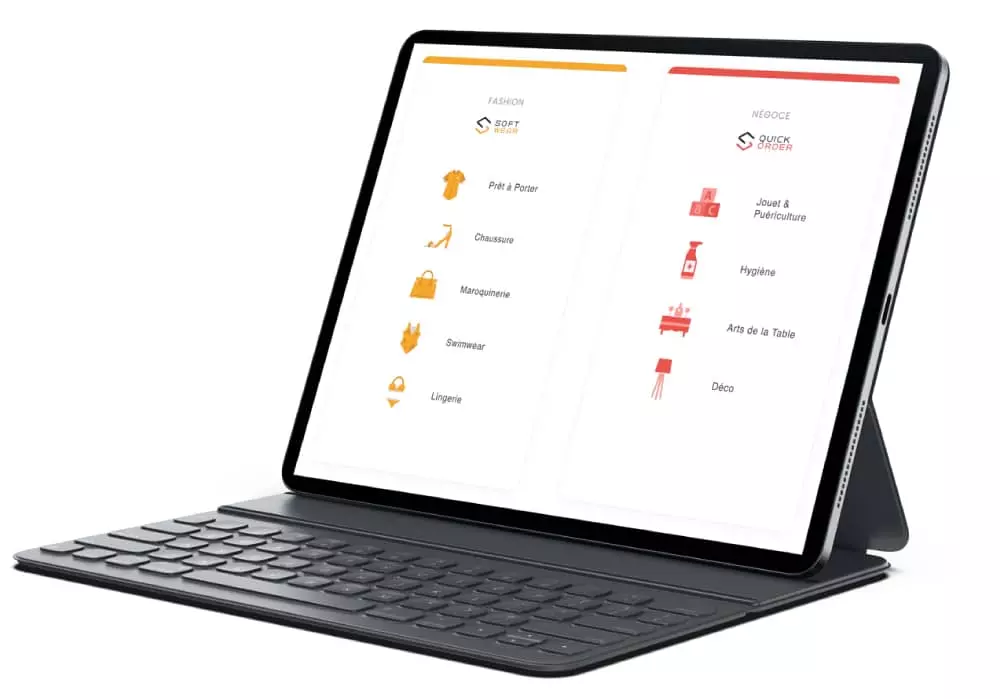After-sales service plays a key role in the relationship between a brand and its customers. It encompasses the management of complaints, returns, and exchanges of defective or non-compliant products.
B2B After-Sales Management: How Can a Service eCommerce Platform Help You?
After-sales service (SAV) plays a key role in the relationship between a brand and its customers. It encompasses the management of complaints, returns, and exchanges of defective or non-compliant products.
A well-managed after-sales process can turn a negative experience into an opportunity to retain a customer and enhance the brand’s image.
But beyond handling requests, after-sales service is part of a broader approach: the range of services offered to customers. The digital shift doesn’t only involve automating order processes — it also extends to services, which are a crucial lever for differentiation and customer satisfaction.
A well-designed B2B service eCommerce platform not only optimizes after-sales management but also strengthens distributor engagement by offering them easy access to all brand services.
Let’s take a closer look at the main challenges brands face in managing after-sales requests and how a B2B service platform can provide an effective, strategic solution.
1. Key Challenges in After-Sales Management
Lack of customer autonomy in creating after-sales requests
Customers expect quick responses to their after-sales issues. When they have to call or email to initiate a request, the process slows down — extending the time needed to log, process, and resolve a claim.
Best practice: Offer a dedicated online space where customers can independently submit their after-sales requests and provide all necessary details (issue encountered, claim description, photos, etc.). This simplifies the customer experience and speeds up processing times.
Slow processing times and lack of regular communication
Customers want to be kept informed about the progress and expected resolution of their requests. Late responses, inconsistent communication, or poor request handling often lead to frustration.
Best practice: In addition to training your teams in after-sales management, define a clear internal policy and process aligned with your general terms and conditions (GTC). Establish clear rules for exchanges, refunds, and timelines to improve efficiency and ensure consistent communication with customers.
Lack of visibility on request status
When customers don’t know if their request has been received or are unaware of its progress, it creates frustration and erodes trust.
Best practice: Provide transparent tracking through a status system visible to customers (e.g. “in progress,” “validated,” “returned product”). Notify them by email or within their client space at each key step.
Difficulty managing dispersed or manual data
When after-sales requests are scattered across tools or managed manually, it increases the risk of errors, duplication, and wasted time for teams.
Best practice: Managing after-sales requests through a web platform centralizes all claims in one place. This improves visibility, information sharing, and coordination between teams and clients.
Importance of internal and external feedback
Understanding recurring issues or weak points in your commercial processes is essential to improving efficiency.
Best practice: Regularly collect feedback from your teams and analyze KPIs such as average resolution times or post-service satisfaction rates. This helps you identify patterns, detect areas for improvement, and implement corrective actions.
It’s all about brand reputation
Poor after-sales management can seriously harm your brand image.
Best practice: View every after-sales request as an opportunity to strengthen the customer relationship. Handling an issue efficiently can turn a negative experience into a positive testimonial for your brand.
2. A B2B Service Platform: A Powerful Lever for Differentiation and Engagement
The digital transformation goes beyond digitizing order processes. It also encompasses the services offered to customers — to make interactions smoother and strengthen engagement.
A B2B service platform centralizes these interactions in one single space, allowing buyers to easily access all the tools and services they need: commercial conditions, order tracking, backorders, marketing materials (POS, visuals, etc.), after-sales requests, returns management, customer support, and more.
By integrating all these services in one accessible environment, a service eCommerce platform offers a fluid and intuitive experience. No more scattered emails or multiple tools — everything is centralized, structured, and optimized, helping clients save time and strengthening their satisfaction and loyalty.
Among these services, after-sales management plays a key role. A digital and efficient after-sales process naturally encourages customers to use the platform more often. With faster response times, precise tracking, and transparent communication, after-sales becomes a gateway to wider platform adoption. Once customers get used to using it for claims, they’ll naturally explore other services — driving regular and sustained use.
In a highly competitive B2B environment, the quality of customer services is a real differentiator. A well-structured B2B service platform transforms the customer experience and becomes a strategic asset for the brand.
3. Discover SCJ’s B2B Service Platform Add-On: After-Sales & Returns Management
With SCJ’s After-Sales & Returns Management add-on, you can efficiently manage your distributors’ claims and return requests — responding quickly to their needs and increasing satisfaction.
The add-on is available across our B2B platforms, depending on your industry:
SAV Softwear add-on for fashion brands: ready-to-wear, footwear, leather goods, lingerie, swimwear, sportswear, and accessories.
SAV Quickorder add-on for wholesale and distribution industries: home decor, tableware, linens, toys, childcare, hygiene, and more.
Empowering customers and saving time
Through the SCJ B2B platform, clients can log into their dedicated customer space and create their after-sales requests independently. They can specify the reason for the request and attach photos for additional context.
Regular communication and transparent tracking
Customers can follow the progress of their request directly in their client space. A status indicator shows the stage of processing, and they receive an email notification once their request has been updated.
Centralized information for optimized after-sales management
From the platform’s back office, your sales teams can view all customer after-sales requests in one place — simplifying management and follow-up.
Each request can be viewed in detail and processed efficiently, with full traceability. Teams can interact directly with customers, request additional details, and accept or reject claims with explanations.
By adopting our After-Sales & Returns Management Add-On, you transform after-sales handling into a simple, fast, and efficient process — for both your teams and your clients. Improve customer satisfaction, optimize workflows, and boost productivity.
👉 Discover our solution today and turn after-sales management into a strategic advantage for your brand!
But beyond handling requests, after-sales service is part of a broader approach: the range of services offered to customers. The digital shift doesn’t only involve automating order processes — it also extends to services, which are a crucial lever for differentiation and customer satisfaction.
A well-designed B2B service eCommerce platform not only optimizes after-sales management but also strengthens distributor engagement by offering them easy access to all brand services.
Let’s take a closer look at the main challenges brands face in managing after-sales requests and how a B2B service platform can provide an effective, strategic solution.
1. Key challenges in after-sales management
- Lack of customer autonomy in creating after-sales requests
Customers expect quick responses to their after-sales issues. When they have to call or email to initiate a request, the process slows down — extending the time needed to log, process, and resolve a claim.
Best practice : Offer a dedicated online space where customers can independently submit their after-sales requests and provide all necessary details (issue encountered, claim description, photos, etc.). This simplifies the customer experience and speeds up processing times.
- Slow processing times and lack of regular communication
Customers want to be kept informed about the progress and expected resolution of their requests. Late responses, inconsistent communication, or poor request handling often lead to frustration.
Best practice : In addition to training your teams in after-sales management, define a clear internal policy and process aligned with your general terms and conditions . Establish clear rules for exchanges, refunds and timelines to improve efficiency and ensure consistent communication with customers.
- Lack of visibility on request status
When customers don’t know if their request has been received or are unaware of its progress, it creates frustration and erodes trust.
Best practice : Provide transparent tracking through a status system visible to customers (e.g. “in progress,” “validated,” “returned product”). Notify them by email or within their client space at each key step.
- Difficulty managing dispersed or manual data
When after-sales requests are scattered across tools or managed manually, it increases the risk of errors, duplication, and wasted time for teams.
Best practice: Managing after-sales requests through a web platform centralizes all claims in one place. This improves visibility, information sharing and coordination between your teams and your clients.
- Importance of internal and external feedback
Understanding recurring issues or weak points in your commercial processes is essential to improving efficiency.
Best practice : Regularly collect feedback from your teams and analyze KPIs such as average resolution times or post-service satisfaction rates. This helps you identify patterns, detect areas for improvement, and implement corrective actions.

- The image of your company is at stake
Poor after-sales management can seriously harm your brand image.
Best practice : View every after-sales request as an opportunity to strengthen the customer relationship. Handling an issue efficiently can turn a negative experience into a positive testimonial for your brand.
2. A B2B service platform: a powerful lever for differentiation and engagement
The digital transformation goes beyond digitizing order processes. It also encompasses the services offered to customers — to make interactions smoother and strengthen engagement.
A B2B service platform centralizes these interactions in one single space, allowing buyers to easily access all the tools and services they need: commercial conditions, order tracking, backorders, marketing materials (POS, visuals, etc.), after-sales requests, returns management, customer support and more.
By integrating all these services in one accessible environment, a service eCommerce platform offers a fluid and intuitive experience. No more scattered emails or multiple tools — everything is centralized, structured, and optimized, helping clients save time and strengthening their satisfaction and loyalty.
Among these services, after-sales management plays a key role. A digital and efficient after-sales process naturally encourages customers to use the platform more often. With faster response times, precise tracking, and transparent communication, after-sales becomes a gateway to wider platform adoption. Once customers get used to using it for claims, they’ll naturally explore other services — driving regular and sustained use.
In a highly competitive B2B environment, the quality of customer services is a real differentiator. A well-structured B2B service platform transforms the customer experience and becomes a strategic asset for the brand.

3. Discover our B2B Platform Add-On : After-Sales & Returns Management
With our After-Sales & Returns Management add-on, you can efficiently manage your distributors’ claims and return requests — responding quickly to their needs and increasing satisfaction.
The add-on is available across our B2B platforms, depending on your industry :
- Softwear After-Sales Service Add-on for fashion brands: ready-to-wear, footwear, leather goods, lingerie, swimwear, sportswear, and accessories.
- Quickorder Aflter-Sales Service Add-on for wholesale industries: home decor, tableware, linens, toys, childcare, hygiene and more.
- Empowering customers and saving time
Through the SCJ B2B platform, clients can log into their dedicated customer space and create their after-sales requests independently. They can specify the reason for the request and attach photos for additional context.
- Regular communication and transparent tracking
Customers can follow the progress of their request directly in their client space. A status indicator shows the stage of processing, and they receive an email notification once their request has been updated.

- Centralized information for optimized after-sales management
From the platform’s back-office, your sales teams can view all customer after-sales requests in one place — simplifying management and follow-up.
Each request can be viewed in detail and processed efficiently, with full traceability.
Teams can interact directly with customers, request additional details, and accept or reject claims with explanations.
By adopting our After-Sales & Returns Management Add-On, you transform after-sales handling into a simple, fast, and efficient process — for both your teams and your clients. Improve customer satisfaction, optimize workflows and boost productivity.
Discover our solution today and turn after-sales management into a strategic advantage for your brand!










